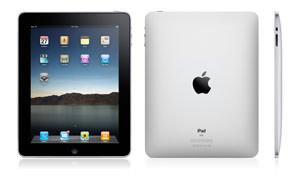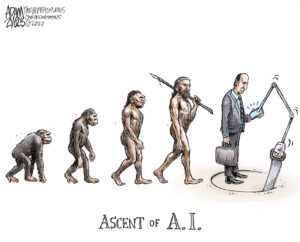Tabletus Interruptus
Steve Jobs calls his new tablet "a magical device at a breakthrough price," but chances are you don't need one and can't afford it anyway.
Update 3:
Every few months I think about this post and groan. The iPad represents the biggest crisis of my tech-loving life: the shiny gadget everyone wants — everyone but me. I’m used to having to explain to people why I want to spend all of my money on a piece of technology they just don’t get, not the other way around. Alas, I must admit that I got this wrong. Apple won. Google hasn’t come through. HP couldn’t sell a tablet that cost more than $100 (there’s a lesson in that). Maybe one day I’ll split the difference and get a MacBook Air.
Update 2: This tweeted observation from William Gibson, the novelist who coined the term cyberspace (for the non-nerds who don’t know and love William Gibson), is enlightening: “Like Twitter,the iPad seems ridiculous until you’re actively within the experience. It’s post-‘computer’, slightly. iPad cowboys unlikely.”
Update: Since I first wrote down these impressions of the iPad on the day it was announced, Apple has sold millions of units, dozens of competitors are set to flood the market with their own tablets and my roommate has told me about 300 times how much he loves his. In this context, the headline “iFail” just seems wrong, given Apple’s success.
But I’m not ready to eat my words. It boils down to this: The iPad is just too expensive to justify what it actually does. It’s great for watching movies on a plane or reading blogs in bed, but it’s still too crippled for the money. That roommate I mentioned? He keeps his crummy old laptop around to instant-message friends and type e-mails. And while Apple may be selling iPads like crazy, we don’t yet know how many customers opted not to get a more expensive Macbook or the iPod Touch they were planning on buying.
Apple deserves credit for once again producing a hit when many, including myself, doubted. But I don’t want one. Not for the money. I’m still holding my breath for an Android tablet — preferably one that isn’t terrible — somewhere in the $200 range.
*****
Steve Jobs calls his new tablet “a magical device at a breakthrough price,” but chances are you don’t need one and can’t afford it anyway.
It’s basically a giant iPhone that goes for $729. It costs more if you want more storage, less if you can do without mobile broadband and don’t need as much room for videos, music and so forth. With six models to choose from –16-, 32- and 64-gigabyte flavors, each with or without a 3G radio — prices range from $499 to $829.
That’s about two to three times as expensive as most netbooks, those inexpensive miniature laptops that Steve Jobs treated with such derision at the beginning of his iPad presentation. Of course Apple hates netbooks — there’s no way to charge an outrageous premium on a zero-margin product. But customers love them. Netbook sales shot up 103 percent in 2009, and Apple wants in on that bigger-than-a-smartphone-smaller-than-a-laptop honey. Hence the iPad.
So what does it do? Pretty much everything your iPhone or iPod Touch already does, only faster and on a slightly-smaller-than-10-inch screen. You can browse the Web, check your e-mail, watch a movie, play games and so on. The 3G models can get the Internet on the go, provided AT&T’s worthless 3G network obliges. On the plus side, users won’t be locked into a contract with Ma Bell and can pre-purchase unlimited data a month at a time for $30.
The more robust specs and bigger screen could lead to different kinds of applications that just don’t make sense on the smaller iPhone. A new version of iWork, for example, is supposed to make this a more productive mobile device. If Adobe were to release an iPad-optimized version of Photoshop, we could almost run Truthdig from this thing.
The iPad promises to do better at entertaining, as well. Apple is launching a new bookstore with the tablet, although it remains to be seen how long one can tolerate reading books on a backlit LCD screen. There’s a reason Amazon’s Kindle uses that crummy-looking E Ink display — its high-contrast unlit pixels are easier on the eyes and the battery.
It’s really up to developers to take advantage of the iPad. If they embrace it as they have the iPhone, then it has huge, category-disrupting potential. If all we get is mobile iWork and still no multitasking, it’s hard to imagine this as anything more than a glorified iPod or a dumbed-down laptop.
Apple may see this as a netbook killer, but that’s aiming the bar pretty low. Netbooks are cheap and small and that’s about it. They really shouldn’t be too hard to kill. And at least netbooks have built-in keyboards and cameras, which the iPad lacks. Even the iPod Nano has a camera. Come on, Steve.
Netbooks are the wrong foe for the iPad. They’re just completely different kinds of machines. For one thing, netbooks are capable of running the latest version of Windows and many of the programs that require a real desktop operating system. The iPad runs the iPhone OS, a capable mobile operating system, but not something on which you’d fire up Quicken. Netbooks are also substantially cheaper than the iPad. In this price range, it’s more fairly compared to the thin-and-light notebooks inspired by Apple’s own MacBook Air. You can get a good one with a lot more functionality for about the same price.
Apple so loves the idea of using the iPad in a living room environment that they dragged a couch on stage. But the image of Steve Jobs in full-lounge balancing this thing in one hand just raised more doubts. For one thing, try holding a legal pad in front of your face for a few hours and tell me your wrist doesn’t rebel. The iPad has a virtual keyboard, but how exactly does one type on this thing? It’s too big to thumb-type. Are we supposed to rest it on our laps or desks and just deal with the inevitable neck strain?
Apple has tried to address the ergonomic problem with some handy accessories. There’s a keyboard dock (an innovation the company has steadfastly opposed for the iPhone), which makes a compelling argument for leaving the laptop at home. Depending on how portable and comfortable it is, this accessory could do wonders for the iPad and anyone who entertains fantasies of using it for actual work. There’s also a case that allows you to prop up the screen for movie watching and the predictable dock.
All of these add-ons will surely help, but they shouldn’t be necessary. If this is such a great new form factor, why isn’t its naked, unmodified state good enough? This is not an insignificant problem. Microsoft and a half-dozen of its partners have been pushing this shape of device for years over the objections of consumers. Much of the hype leading up to Apple’s Wednesday event had to do with expectations about how the company was going to fix the basic shortcomings of the tablet as we know it. They didn’t.
Why does anyone need the iPad? Does it replace either your smartphone or your laptop? No. Does it do something those devices can’t? No. If you go on a business trip, can you afford to leave either device behind? No. Is $500 at the bottom end (and $829 at the top) really worth it? Commuters, frequent fliers and Star Trek fans might think so. The rest of us are better off sticking to the less magical gadgets we already own.
Your support matters…Independent journalism is under threat and overshadowed by heavily funded mainstream media.
You can help level the playing field. Become a member.
Your tax-deductible contribution keeps us digging beneath the headlines to give you thought-provoking, investigative reporting and analysis that unearths what's really happening- without compromise.
Give today to support our courageous, independent journalists.






You need to be a supporter to comment.
There are currently no responses to this article.
Be the first to respond.